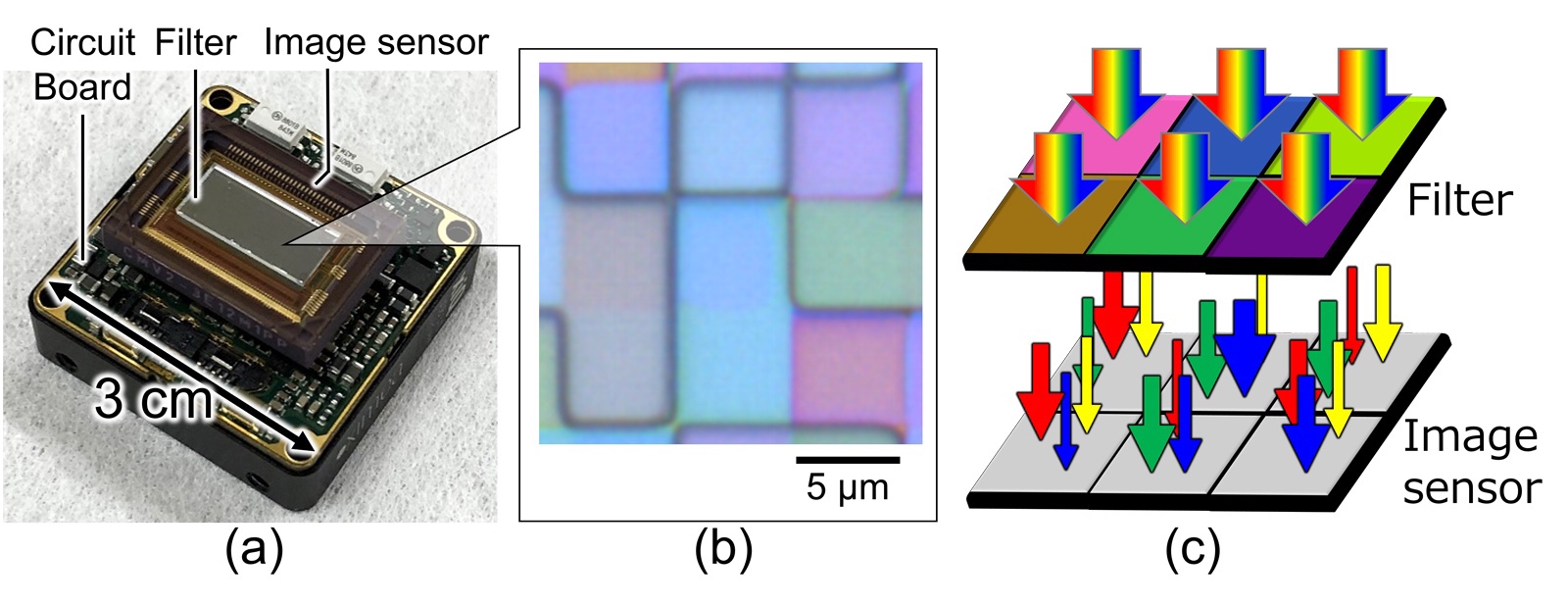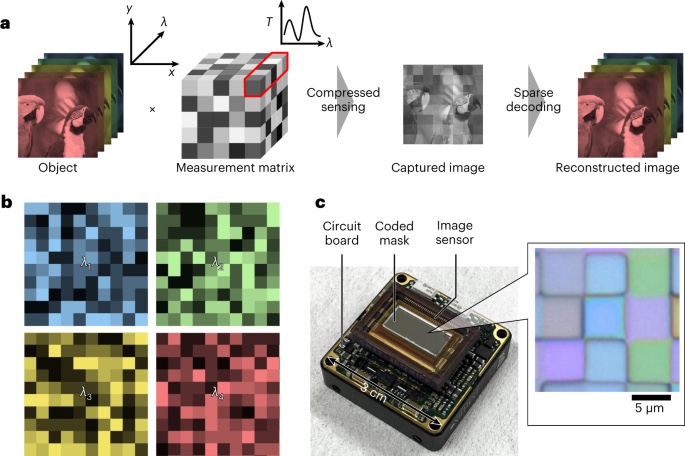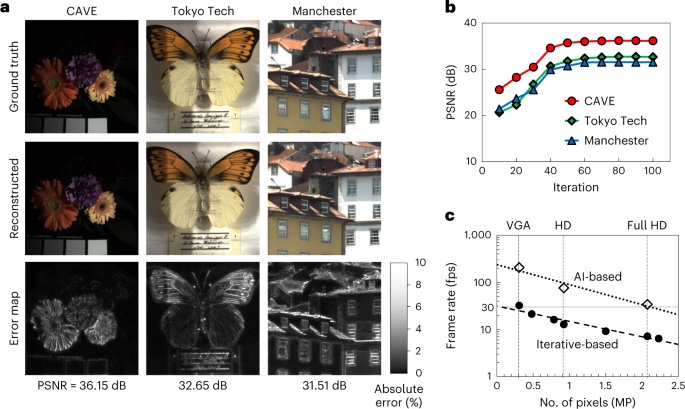


World’s Highest Sensitivity: ハイパースペクトルイメージング!
l’imagerie hyperspectrale !
Hyperspektrale Bildgebung!
Hyperspectral Imaging!
世界上最高的靈敏度:高光譜成像!
ーパナソニックとベルギー・imecが共同開発ー
パナソニック:
パナソニックが、世界最高感度のハイパースペクトルイメージング技術を開発した。
「医療や宇宙探索の分野で活用が進む、圧縮センシング技術」を用いて開発した。
高感度ハイパースペクトル
画像撮影技術ー工場での外観検査などで導入ー
マシンビジョン用途の拡大を、パートナーとの共創を検討する。
新技術の導入:
肉眼では判別できないわずかな色の違いを、従来のカラーカメラと同様の操作性で識別できる。
画像分析・認識の精度向上が可能になる。
ベルギー
研究機関imec世界初の研究成果として、ベルギーの研究機関imecと連名で、
光学分野の「Nature Photonics」オンライン版に24日(日本時間)掲載した。
特殊フィルターを開発:
ハイパースペクトル画像撮影技術では、「複数波長の光を通す特殊フィルター」を開発した。
市販イメージセンサー上に搭載できる。
通ってきた光(波長)を、「独自のデジタル画像処理アルゴリズム」でデータ復元する。
特殊フィルターの役割:
- 特殊フィルターは、対象から放たれた光を、
- 画素ごと・波長ごとの強度をランダムに変えて、
- 通すように設計されている。
色情報を、効率的に間引いて検出する。
複数波長の光が通るので、イメージセンサーが検出する光が増え、感度が向上する。
特殊フィルターの感度:
開発した特殊フィルターは、入射光の45%を通す。
「従来技術における光利用効率(5%以下)」に比べ10倍高く、世界最高の感度だ。
「一般的なオフィス照明程度の明るさ(550ルクス)」でも、明瞭に撮影できる。
画像分析精度が向上:
20波長と非常に多くの色情報を検出できる。
「赤・緑・青の3色のみを見分けられる、肉眼やカラーカメラ」に比べ、画像認識精度が向上する。
特殊フィルターの用途:
- 感度が高いため、短いシャッター時間で撮影可能。
- ソフト上での色分離を、独自アルゴリズムで高速化。
「フレームレートが30fpsを超えた高速なハイパースペクトル画像の取得」に成功した。
- ピント、位置合わせなどの操作が容易、
- 生鮮食品の鮮度や医薬品の検査、
- 人の目で判別できない塗装ムラの検出、
幅広い応用が期待できる。
(電波新聞デジタル) – Yahoo!ニュース
https://news.yahoo.co.jp/articles/fdb142109ad6d68831ea0a29dcceac8f00a534a9
Video-rate hyperspectral camera based on a CMOS-compatible random array of Fabry–Pérot filters | Nature Photonics
https://www.nature.com/articles/s41566-022-01141-5
La sensibilité la plus élevée au monde : l’imagerie hyperspectrale !
-Développé conjointement par Panasonic et imec de Belgique-
Panasonic :
Panasonic a développé une technologie d’imagerie hyperspectrale avec la sensibilité la plus élevée au monde.
Il a été développé en utilisant “la technologie de détection compressée, qui est utilisée dans les domaines médical et de l’exploration spatiale”.
Hyperspectral haute sensibilité
technologie d’imagerie
ー Introduit pour les inspections d’apparence dans les usines ー
Envisagez la co-création avec des partenaires pour étendre les applications de vision industrielle.
Introduction de nouvelles technologies :
De légères différences de couleur qui ne peuvent pas être discernées à l’œil nu peuvent être discernées avec la même opérabilité qu’une caméra couleur conventionnelle.
Il est possible d’améliorer la précision de l’analyse et de la reconnaissance des images.
Belgique
institut de recherche imec
En tant que premier résultat de recherche au monde, en collaboration avec l’institut de recherche belge imec,
Il a été publié dans la version en ligne de “Nature Photonics” dans le domaine de l’optique le 24 (heure du Japon).
Filtres spéciaux développés :
Pour la technologie d’imagerie hyperspectrale, nous avons développé un filtre spécial qui laisse passer la lumière de plusieurs longueurs d’onde.
Il peut être monté sur un capteur d’image disponible dans le commerce.
Les données de la lumière (longueur d’onde) qui a traversé sont restaurées à l’aide d’un “algorithme unique de traitement d’image numérique”.
Rôle des filtres spéciaux :
Le filtre spécial filtre la lumière émise par la cible,
En changeant aléatoirement l’intensité de chaque pixel et de chaque longueur d’onde,
conçu pour traverser.
Pour éclaircir et détecter efficacement les informations de couleur.
Étant donné que la lumière de plusieurs longueurs d’onde passe à travers, plus de lumière peut être détectée par le capteur d’image, améliorant sa sensibilité.
Sensibilité spéciale du filtre :
Le filtre spécial développé laisse passer 45 % de la lumière incidente.
Il est 10 fois plus élevé que “l’efficacité d’utilisation de la lumière de la technologie conventionnelle (5% ou moins)” et la sensibilité la plus élevée au monde.
Vous pouvez filmer clairement même avec “la luminosité de l’éclairage général du bureau (550 lux)”.
Amélioration de la précision de l’analyse des images :
Il peut détecter 20 longueurs d’onde et une grande quantité d’informations de couleur.
La précision de la reconnaissance d’image est améliorée par rapport aux “yeux nus et aux caméras couleur qui ne peuvent distinguer que trois couleurs, le rouge, le vert et le bleu”.
Applications des filtres spéciaux :
La sensibilité élevée permet de prendre des photos avec un temps d’obturation court.
La séparation des couleurs sur le logiciel est accélérée grâce à un algorithme unique.
Nous avons réussi “l’acquisition d’images hyperspectrales à haute vitesse avec une fréquence d’images supérieure à 30 fps”.
Opérations simples telles que la mise au point et le positionnement
Contrôle de fraîcheur des denrées périssables et pharmaceutiques,
Détection d’irrégularités de revêtement non discernables par l’œil humain,
Une large gamme d’applications peut être attendue.
(Denpa Shimbun Digital) – Yahoo Actualités
Weltweit höchste Empfindlichkeit: Hyperspektrale Bildgebung!
-Gemeinsam entwickelt von Panasonic und imec aus Belgien-
Panasonic:
Panasonic hat eine hyperspektrale Bildgebungstechnologie mit der weltweit höchsten Empfindlichkeit entwickelt.
Es wurde unter Verwendung von “komprimierter Sensortechnologie entwickelt, die in den Bereichen Medizin und Weltraumforschung eingesetzt wird”.
Hyperspektral mit hoher Empfindlichkeit
bildgebende Technologie
ーEingeführt für Erscheinungsinspektionen in Fabrikenー
Erwägen Sie die gemeinsame Entwicklung mit Partnern, um Anwendungen für maschinelles Sehen zu erweitern.
Einführung neuer Technologien:
Leichte Farbunterschiede, die mit bloßem Auge nicht erkennbar sind, können mit der gleichen Bedienbarkeit wie bei einer herkömmlichen Farbkamera erkannt werden.
Es ist möglich, die Genauigkeit der Bildanalyse und -erkennung zu verbessern.
Belgien
Forschungsinstitut imec
Als weltweit erstes Forschungsergebnis, gemeinsam mit dem belgischen Forschungsinstitut imec,
Es wurde in der Online-Version von „Nature Photonics“ im Bereich Optik am 24. (japanische Zeit) veröffentlicht.
Entwickelte Spezialfilter:
Für die hyperspektrale Bildgebungstechnologie haben wir einen speziellen Filter entwickelt, der Licht mehrerer Wellenlängen durchlässt.
Es kann auf einem handelsüblichen Bildsensor montiert werden.
Die Daten des durchgegangenen Lichts (Wellenlänge) werden mit einem „einzigartigen digitalen Bildverarbeitungsalgorithmus“ wiederhergestellt.
Rolle von Spezialfiltern:
Der Spezialfilter filtert das vom Ziel emittierte Licht,
Durch zufälliges Ändern der Intensität jedes Pixels und jeder Wellenlänge,
zum Durchfahren ausgelegt.
Zum effizienten Ausdünnen und Erkennen von Farbinformationen.
Da Licht mit mehreren Wellenlängen hindurchgeht, kann mehr Licht vom Bildsensor erfasst werden, wodurch seine Empfindlichkeit verbessert wird.
Spezielle Filterempfindlichkeit:
Der entwickelte Spezialfilter lässt 45 % des einfallenden Lichts durch.
Sie ist zehnmal höher als die „Lichtnutzungseffizienz herkömmlicher Technologie (5 % oder weniger)“ und die weltweit höchste Empfindlichkeit.
Sie können auch mit “Helligkeit der allgemeinen Bürobeleuchtung (550 Lux)” scharfe Aufnahmen machen.
Verbesserte Genauigkeit der Bildanalyse:
Es kann 20 Wellenlängen und eine große Menge an Farbinformationen erkennen.
Die Bilderkennungsgenauigkeit wird im Vergleich zu „mit bloßem Auge und Farbkameras, die nur drei Farben, Rot, Grün und Blau, unterscheiden können“, verbessert.
Anwendungen von Spezialfiltern:
Die hohe Empfindlichkeit ermöglicht Aufnahmen mit kurzer Verschlusszeit.
Die Farbtrennung in der Software wird durch einen einzigartigen Algorithmus beschleunigt.
Uns gelang die „Erfassung von Hochgeschwindigkeits-Hyperspektralbildern mit einer Bildrate von mehr als 30 fps“.
Einfache Operationen wie Fokussieren und Positionieren
Frischekontrolle von verderblichen Waren und Arzneimitteln,
Erkennung von Beschichtungsunregelmäßigkeiten, die für das menschliche Auge nicht erkennbar sind,
Ein breites Anwendungsspektrum ist zu erwarten.
(Denpa Shimbun Digital) – Yahoo!-Nachrichten
Panasonic Develops Hyperspectral Imaging Technology with the World’s Highest Sensitivity
Panasonic Newsroom Global
The newly developed hyperspectral imaging technology employs compressed sensing,
which efficiently acquires observation data by “thinning out” and reconstructing data to restore data to what it was before thinning out through image post-processing.
The compressed sensing technology
is also used in MRI examinations in the medical field as well as black hole observations.
A special filter
that transmits multiple wavelengths of light to appropriately thin out data is implemented on an image sensor (Fig. 1),
and the image reconstruction is carried out by a uniquely optimized algorithm for digital image processing.
By leaving a part of the color-separating functions to the software,
Panasonic Holdings have overcome the trade-off between the number of wavelengths and sensitivity, the fundamental issue of conventional technology.
This approach has made it possible
to capture hyperspectral images with the world’s highest sensitivity (Fig. 2) and video (Fig. 3) under indoor illumination (550 lux).
Utilizing the developed technology, Panasonic Holdings will collaborate with our partners to provide new spectral sensing solutions,
including highly accurate image analysis and recognition, and to expand machine vision applications with highly sensitive hyperspectral imaging technology.
Main features
1. Improve sensitivity beyond physical restrictions through data acquisition with thinning out using a special filter randomly transmitting multiple wavelengths of light.
2. Achieves clear images even in indoor illumination (550 lux) through hyperspectral imaging with the world’s highest sensitivity (about 10 times higher than conventional ones).
3. Achieves hyperspectral imaging with color camera-comparable usability by improving frame rates*5 to levels as high as video-rates (over 30 fps) via a uniquely developed algorithm.